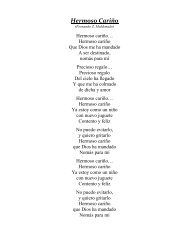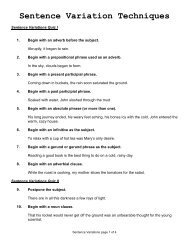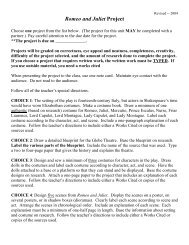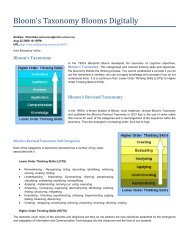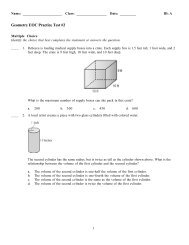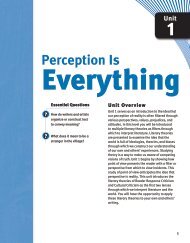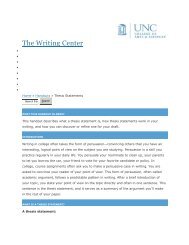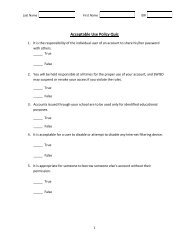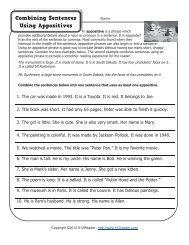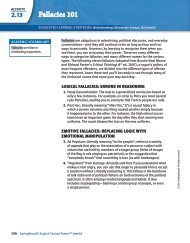EA3- after 1.9.pdf - Moodle High - BCSC
EA3- after 1.9.pdf - Moodle High - BCSC
EA3- after 1.9.pdf - Moodle High - BCSC
You also want an ePaper? Increase the reach of your titles
YUMPU automatically turns print PDFs into web optimized ePapers that Google loves.
Slope, Distance, and Midpoint<br />
GRAPH OF STEEL<br />
Embedded<br />
Assessment 3<br />
Use <strong>after</strong> Activity 1.9.<br />
The first hill of the Steel Dragon 2000 roller coaster in Nagashima, Japan, drops<br />
riders from a height of 318 ft. A portion of this first hill has been transposed onto a<br />
coordinate plane and is shown to the right.<br />
Write your answers on notebook paper or grid paper. Show your work.<br />
1–6: See below.<br />
1. The structure of the supports for the hill consists of steel beams that<br />
run parallel and perpendicular to one another. The endpoints of the<br />
longer of the two support beams highlighted in Quadrant I are (0, 150)<br />
and (120, 0). If the endpoints of the other highlighted support beam<br />
are (0, 125) and (100, 0), verify and explain why the two beams are<br />
parallel.<br />
2. Determine the equations of the lines containing the beams from Item<br />
1, and explain how the equations of the lines can help you determine<br />
that the beams are parallel.<br />
y<br />
3. The equation of a line containing another support beam is<br />
y = 4__ x + 150. Determine whether this beam is parallel or<br />
5<br />
perpendicular to the other two beams, and explain your reasoning.<br />
4. A linear portion of the first drop is also highlighted in the photo<br />
and has endpoints of (62, 258) and (110, 132). To the nearest foot,<br />
determine the distance between the endpoints of the linear section of the track.<br />
Justify your result by showing your work.<br />
x<br />
5. A camera is being installed at the midpoint of the linear portion of the track<br />
described in Item 4. Determine the coordinates where this camera should be<br />
placed.<br />
© 2010 College Board. All rights reserved.<br />
6. Explain how you could use the distance formula to verify that the coordinates<br />
you determined for the midpoint are correct.<br />
Unit 1 • Proof, Parallel and Perpendicular Lines 81
Embedded<br />
Assessment 3<br />
Use <strong>after</strong> Activity 1.9.<br />
Slope, Distance, and Midpoint<br />
GRAPH OF STEEL<br />
Exemplary Proficient Emerging<br />
Math Knowledge<br />
#2, 3, 4, 5<br />
The student:<br />
• Gives the correct<br />
equations for the<br />
parallel lines. (2)<br />
• Determines the<br />
correct relationship<br />
among the beams. (3)<br />
• Determines the correct<br />
distance between the<br />
points. (4)<br />
• Correctly determines<br />
the coordinates of the<br />
midpoint of the linear<br />
section. (5)<br />
The student:<br />
• Gives the correct<br />
equation for one,<br />
but not both, of<br />
the parallel lines.<br />
• Uses a correct<br />
method to<br />
determine the<br />
distance but makes<br />
a computational<br />
error.<br />
• Uses a correct<br />
method to<br />
determine the<br />
coordinates of the<br />
midpoint but makes<br />
a computational<br />
error.<br />
The student:<br />
• Gives incorrect<br />
linear equations.<br />
• Does not determine<br />
the correct<br />
relationship among<br />
the beams.<br />
• Uses an incorrect<br />
method to<br />
determine the<br />
distance.<br />
• Uses an incorrect<br />
method to<br />
determine the<br />
coordinates of the<br />
midpoint.<br />
Representations<br />
#2<br />
The student gives the<br />
correct equations for<br />
the parallel lines. (2)<br />
The student gives<br />
the correct equation<br />
for only one of the<br />
lines.<br />
The student gives<br />
the correct equation<br />
for neither of the<br />
lines.<br />
Communication<br />
#1, 2, 3, 4, 6<br />
The student:<br />
• Verifies and writes a<br />
correct explanation<br />
for the reason the two<br />
beams are parallel. (1)<br />
• Gives a correct<br />
explanation for the<br />
connection between<br />
the equations and the<br />
parallel relationship<br />
of the lines. (2)<br />
• Gives a complete<br />
explanation for the<br />
parallelism and<br />
perpendicularity of<br />
the beams. (3)<br />
• Shows work that is<br />
complete. (4)<br />
• Gives a complete<br />
explanation of how<br />
the distance formula<br />
could be used to<br />
verify the coordinates<br />
of the midpoint. (6)<br />
The student:<br />
• Verifies and writes<br />
an incomplete<br />
explanation for<br />
the reason the two<br />
beams are parallel.<br />
• Gives an<br />
incomplete<br />
explanation for<br />
the connection<br />
between the<br />
equations and the<br />
parallel relationship<br />
of the lines.<br />
• Gives a complete<br />
explanation for the<br />
parallelism or the<br />
perpendicularity of<br />
the beams but not<br />
both.<br />
• Shows incomplete<br />
work that contains<br />
no mathematical<br />
errors.<br />
• Gives an incomplete<br />
explanation of how<br />
the distance formula<br />
could be used for<br />
verification.<br />
The student:<br />
• Says the beams<br />
are parallel, but<br />
does not give an<br />
explanation.<br />
• Gives an incorrect<br />
explanation for the<br />
connection.<br />
• Gives an incorrect<br />
explanation for<br />
the relationship<br />
among the beams.<br />
• Shows incorrect<br />
work<br />
• Gives an incorrect<br />
explanation for the<br />
use of the distance<br />
formula.<br />
© 2010 College Board. All rights reserved.<br />
82 SpringBoard ® Mathematics with Meaning Geometry




